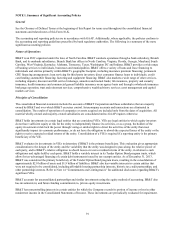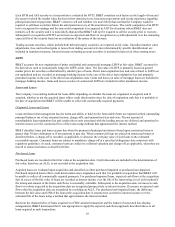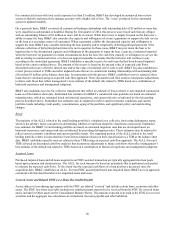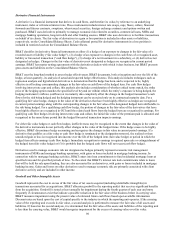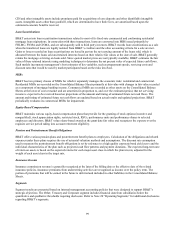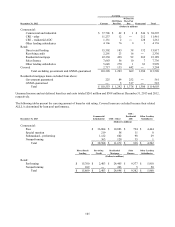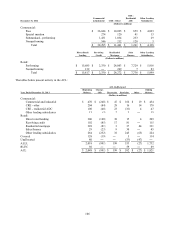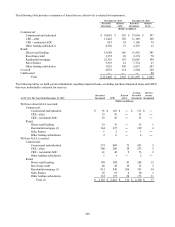BB&T 2013 Annual Report Download - page 99
Download and view the complete annual report
Please find page 99 of the 2013 BB&T annual report below. You can navigate through the pages in the report by either clicking on the pages listed below, or by using the keyword search tool below to find specific information within the annual report.99
CDI and other intangible assets include premiums paid for acquisitions of core deposits and other identifiable intangible
assets. Intangible assets other than goodwill, which are determined to have finite lives, are amortized based upon the
estimated economic benefits received.
Loan Securitizations
BB&T enters into loan securitization transactions related to most of its fixed-rate commercial and conforming residential
mortgage loan originations. In connection with these transactions, loans are converted into MBS issued primarily by
FHLMC, FNMA and GNMA, and are subsequently sold to third party investors. BB&T records loan securitizations as a sale
when the transferred loans are legally isolated from BB&T’s creditors and the other accounting criteria for a sale are met.
Gains or losses recorded on loan securitizations are based in part on the net carrying amount of the loans sold, which is
allocated between the loans sold and retained interests based on their relative fair values at the date of sale. BB&T generally
retains the mortgage servicing on loans sold. Since quoted market prices are not typically available, BB&T estimates the fair
value of these retained interests using modeling techniques to determine the net present value of expected future cash flows.
Such models incorporate management’s best estimates of key variables, such as prepayment speeds, servicing costs and
discount rates that would be used by market participants based on the risks involved.
MSRs
BB&T has two primary classes of MSRs for which it separately manages the economic risks: residential and commercial.
Residential MSRs are recorded on the Consolidated Balance Sheets primarily at fair value with changes in fair value recorded
as a component of mortgage banking income. Commercial MSRs are recorded as other assets on the Consolidated Balance
Sheets at the lower of cost or market and are amortized in proportion to, and over the estimated period, that net servicing
income is expected to be received based on projections of the amount and timing of estimated future net cash flows. The
amount and timing of estimated future net cash flows are updated based on actual results and updated projections. BB&T
periodically evaluates its commercial MSRs for impairment.
Equity-Based Compensation
BB&T maintains various equity-based compensation plans that provide for the granting of stock options (incentive and
nonqualified), stock appreciation rights, restricted stock, RSUs, performance units and performance shares to selected
employees and directors. BB&T values share-based awards at the grant date fair value and recognizes the expense over the
requisite service period taking into account retirement eligibility.
Pension and Postretirement Benefit Obligations
BB&T offers various pension plans and postretirement benefit plans to employees. Calculation of the obligations and related
expenses under these plans requires the use of actuarial valuation methods and assumptions. The discount rate assumption
used to measure the postretirement benefit obligations is set by reference to a high quality corporate bond yield curve and the
individual characteristics of the plan such as projected cash flow patterns and payment durations. The expected long-term rate
of return on assets is based on the expected returns for each major asset class in which the plan invests, adjusted for the
weight of each asset class in the target mix.
Insurance Income
Insurance commission revenue is generally recognized at the later of the billing date or the effective date of the related
insurance policies. Insurance premiums from underwriting activities are recognized as income over the policy term. The
portion of premiums that will be earned in the future is deferred and included in other liabilities in the Consolidated Balance
Sheets.
Segments
Segment results are presented based on internal management accounting policies that were designed to support BB&T’s
strategic objectives. The Other, Treasury and Corporate segment includes financial data from subsidiaries below the
quantitative and qualitative thresholds requiring disclosure. Refer to Note 20 “Operating Segments” for additional disclosures
regarding BB&T’s segments.




